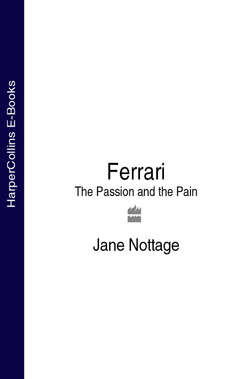Читать книгу Ferrari: The Passion and the Pain - Jane Nottage - Страница 7
Introduction
ОглавлениеThe sound is unmistakable. A deep throaty roar leading to a high-pitched whine. It’s another day, another country and the millionaire boys are playing with their favourite toys. Round and round they go, darting in and out like multi-coloured insects engaged in some ancient ritualistic dance.
Bearing the names of their sponsors like proud warriors they automatically draw attention from the small groups gathered on the slopes overlooking the circuit. National flags wave in the breeze and the onlookers express their delight as their favourite drivers pass by. The cars in their distinct livery, each driver locked in his own private race to go ever faster, dance over the tarmac – gold, grey, black, white with a tartan strip and light blue.
The circus continues, and then from the distant pits another sound is heard and the crowd stirs in eager anticipation. A guttural battle cry is followed by a roar of power as the V10 engine propels the car down the pit lane and onto the glistening track. A flash of scarlet as the founder member of Formula One motor racing joins the rest. Anticipation changes to raw passion, and the fans erupt at the sight and sound of the bright red car driven by the supreme warrior himself.
Michael Schumacher is in a Ferrari. Individually enticing, together they are an unbeatable combination of power and emotion. The brilliant German driver in the car that stirs the heart. Among a family of beauties the Ferrari stands head and shoulders above the others. And not just in Formula One. From the boardrooms of Manhattan to the deserts of Africa, owning a Ferrari is the embodiment of many people’s hopes and dreams, something that represents escape, beauty and the good life. It has also transcended the role of being a mere form of transport and become a focus for the emotions of the whole Italian nation. When Ferrari does well the nation dances, when Ferrari does badly the nation cries.
But what is it like to carry the hopes of a nation? To be responsible for the intangible feelings that ebb and flow around the stable of the prancing horse?
Fast forward to 1998. Dateline: 13 September. Place: Monza, home ground of the famous and fanatical tifosi. The scarlet cars screech past the chequered flag, first and second. Schumacher stands on the top step of the podium, Irvine on the next step down. The crowd and the team are delirious. The magical result, not seen at Ferrari in recent history on their home ground, has revitalized everyone involved. It is the sum total of the determination, effort and skill of so many people, and now everyone can rejoice that the hard work has paid off: Schumacher is back in the contest for the 1998 World Drivers’ Championship; and Ferrari are challenging once again for the Constructors’ title. Of course, as history was to decree at the climax of the season in Japan, it would be the runners-up spot yet again for Ferrari and their German wünderkind. But for now, the glory of Monza was something to behold.
At the end of three progressive seasons, the Ferrari renaissance is well underway. Plots and counter-plots are long forgotten. The pace and reliability of a small red car is what matters. Ferrari might make Machiavelli seem like an innocent but it is the only company to have perpetrated the myth of desire for 50 years, the only Formula One team that attracts a passionate, committed army of supporters throughout the world.
We stand on the threshold of a new millennium and we are still transfixed by the power and emotion generated by the need to feel we can be a part of Ferrari, maybe even one day drive one of their cars. We need to be a part of the dream even if, for some of us, that dream is as elusive as scaling Mount Everest. If the emotion is strong on the outside, what is it like on the inside? Let’s take a journey into the heart of the stable of the prancing horse and find out.
Jane Nottage, London, 1998
